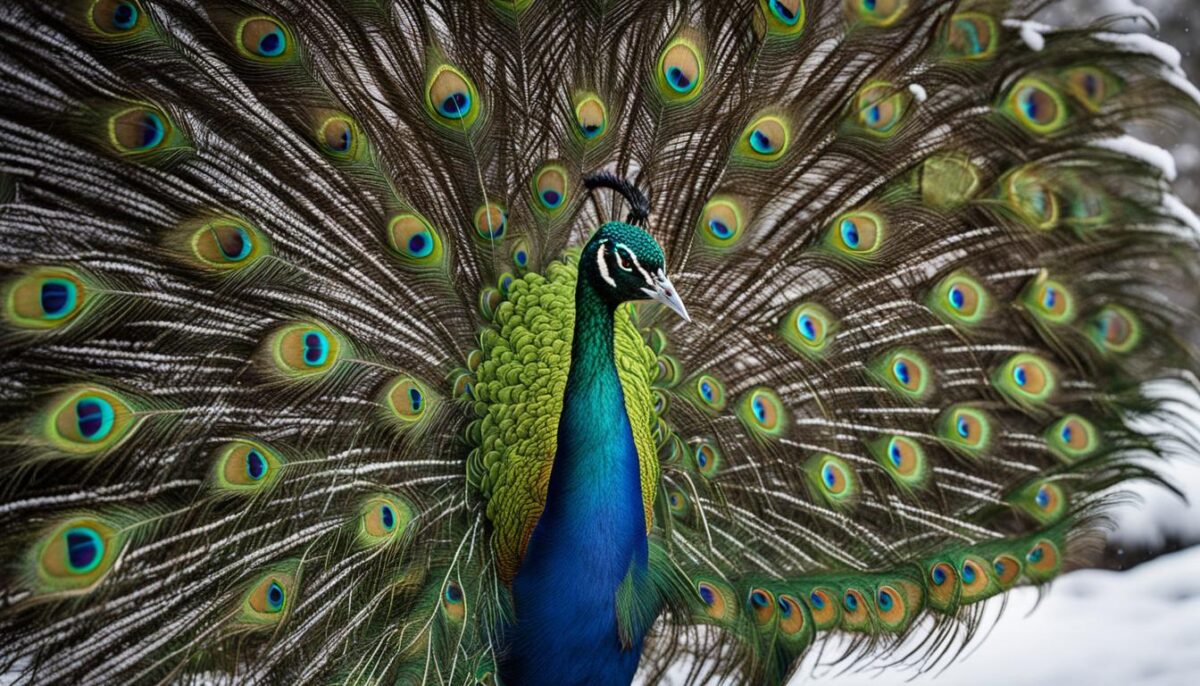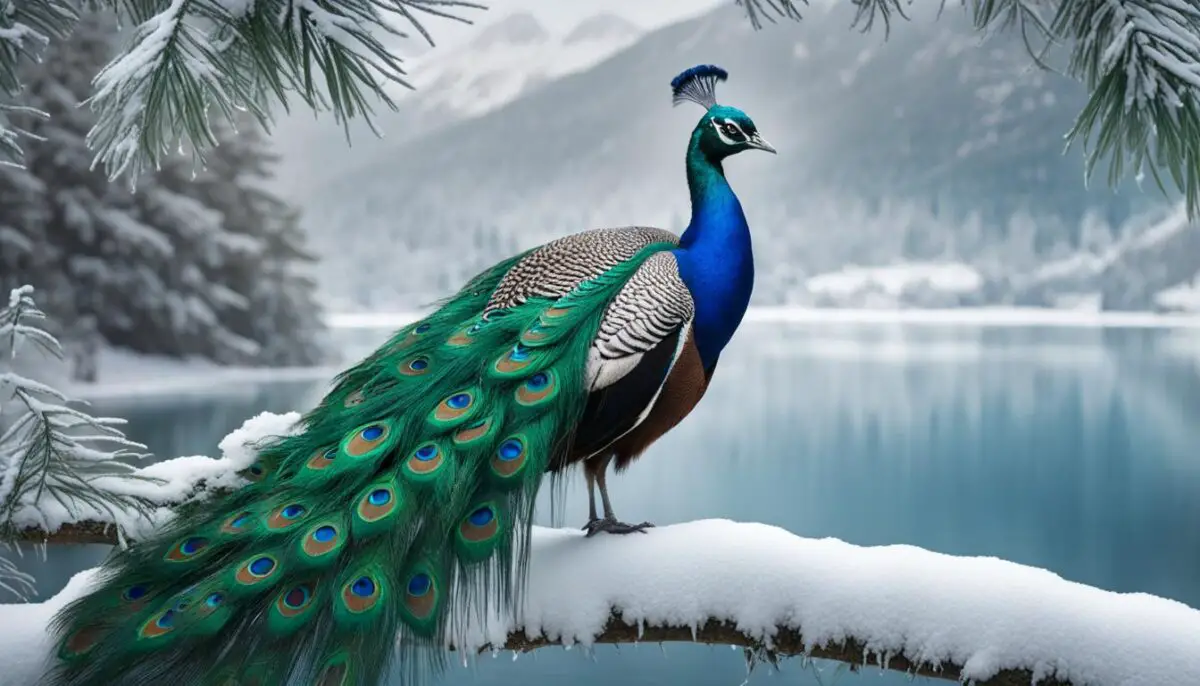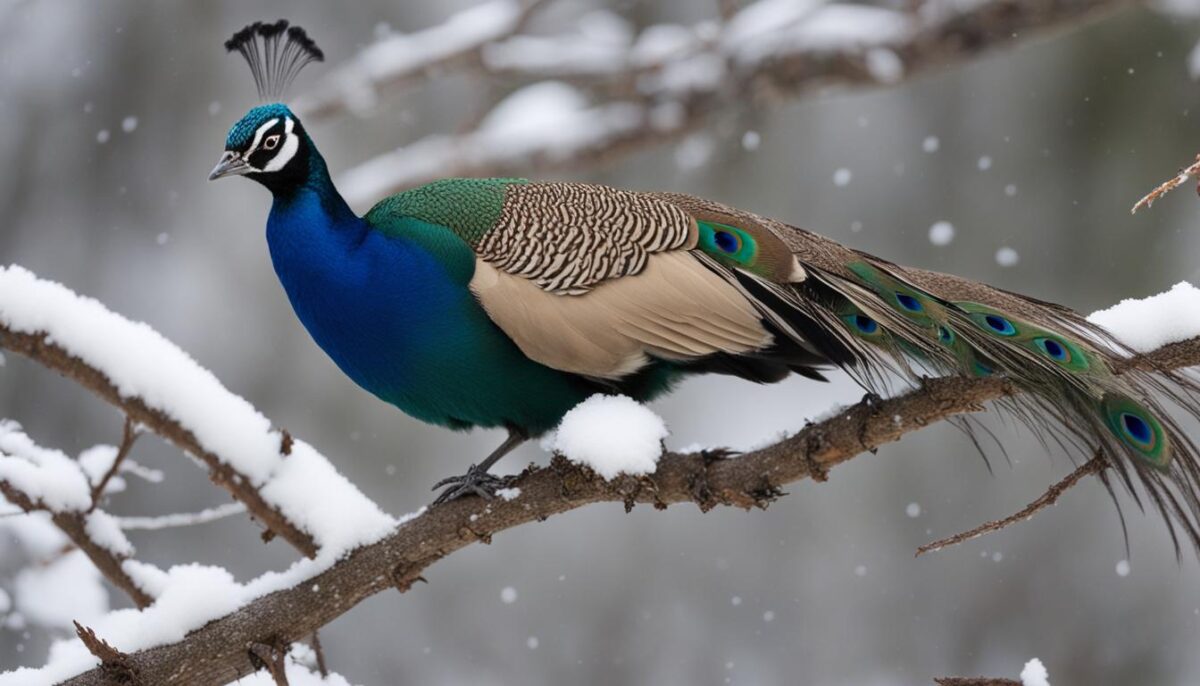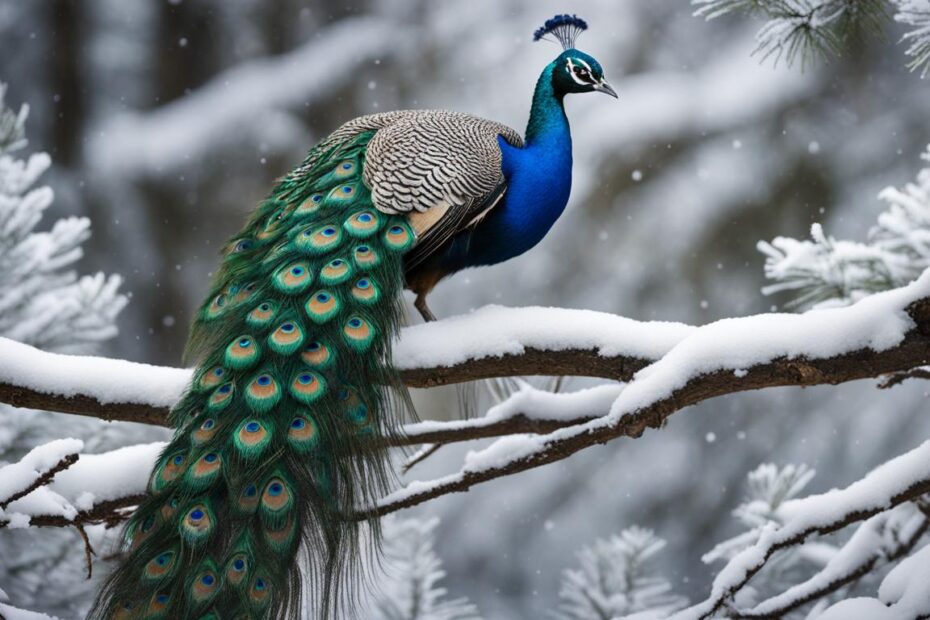Peacocks, with their stunning plumage, are commonly associated with warm climates. However, did you know that these majestic birds have fascinating adaptations that enable them to survive in cold weather as well? In this article, we will explore the cold weather acclimation, wintering strategies, and behavior of peacocks, shedding light on the question: Can peacocks live in cold weather?
Peacocks are not only limited to warm climates. Certain peacock species, such as the Indian peafowl and the Green peafowl, thrive in colder regions, displaying their natural suitability to withstand chilly temperatures. These adaptable birds possess unique traits that help them brave the cold, such as thicker plumage that acts as insulation and the ability to alter their behavior to find shelter and conserve energy during colder months.
Key Takeaways:
- Peacocks have adaptations that allow them to survive in cold weather.
- Certain peacock species are naturally found in cold regions.
- Peacocks alter their behavior in cold weather to seek shelter and conserve energy.
- Providing appropriate care is important for peacocks during winter.
- Peacocks acclimate to cold weather through physiological and behavioral changes.
Peacock Species in Cold Regions
Peacocks are not only found in warm climates but also have species that are naturally adapted to colder regions. Two notable species of peacocks that thrive in cold weather are the Indian peafowl (Pavo cristatus) and the Green peafowl (Pavo muticus). These species have evolved unique characteristics to withstand the challenges of colder temperatures and harsher climates.
The Indian peafowl, also known as the Common peafowl, is native to India and surrounding countries. It has adapted to various habitats, including colder regions such as the Himalayas, where temperatures can drop significantly during winter. The Green peafowl, on the other hand, is native to Southeast Asia and is found in countries like Vietnam, Thailand, and Cambodia. It has the ability to tolerate colder temperatures and can survive in regions with milder winters.
Both the Indian peafowl and the Green peafowl have developed thick plumage that provides insulation against the cold. The feathers trap warm air close to their bodies, helping to maintain a stable internal temperature. Additionally, these species have behavioral adaptations during colder months. They may seek shelter in dense vegetation or roost in trees to protect themselves from the harsh weather conditions. By altering their behavior and utilizing suitable habitats, these peacock species can successfully navigate and thrive in cold regions.
| Peacock Species | Cold Climate Suitability | Cold Weather Behavior |
|---|---|---|
| Indian Peafowl (Pavo cristatus) | High | – Thick plumage for insulation – Seek shelter in dense vegetation – Roost in trees |
| Green Peafowl (Pavo muticus) | Moderate | – Thick plumage for insulation – Able to tolerate milder winters |
Table: Peacock Species Adapted to Cold Regions
Cold Adaptation of Peacocks
Peacocks have remarkable adaptations that enable them to thrive in cold weather conditions. Their ability to survive in chilly temperatures is attributed to a combination of physical attributes and behavioral changes.
One of the key adaptations of peacocks is their feather structure. The dense plumage acts as a natural insulator, providing a layer of warmth during cold weather. Peacocks can also fluff up their feathers to create an additional barrier against the cold. This effective insulation helps them maintain their body temperature even in freezing conditions.
During cold weather, peacocks exhibit significant behavioral changes. They actively seek shelter, such as roosting in trees or finding areas with natural cover, to protect themselves from harsh winds and extreme temperatures. By reducing their activity levels, peacocks conserve energy, ensuring their survival during periods of limited food availability. These behavioral adaptations further contribute to their ability to withstand cold climates.
“Peacocks have developed remarkable cold adaptation strategies, utilizing their feather insulation and altering their behavior to thrive in cold weather conditions.”
The cold adaptation of peacocks allows them to endure and flourish in regions with colder climates. By combining their physical characteristics and behavioral modifications, these magnificent birds have evolved to conquer the challenges posed by cold weather.
| Cold Adaptations of Peacocks | Benefits |
|---|---|
| Dense feather structure | Provides insulation and warmth |
| Fluffing up feathers | Creates additional protection against cold |
| Seeking shelter | Protects from harsh weather elements |
| Reduced activity levels | Conserves energy during periods of limited food availability |
Winter Care for Peacocks
Providing proper winter care for peacocks is essential to ensure their well-being and health during colder months. These beautiful birds have specific needs that must be addressed to help them thrive in cold weather conditions. Here are some key strategies to consider when caring for peacocks in winter:
- Shelter: Peacocks should have access to clean and dry shelter to protect them from harsh weather elements such as rain, snow, and wind. A well-insulated shelter, such as a barn or a coop, can provide the necessary protection while allowing the birds to move around comfortably.
- Nesting materials: Providing peacocks with nesting materials, such as straw or shavings, can help them create warm and cozy nests. This is particularly important for female peafowls that may lay eggs during colder months. The nesting materials will provide insulation and keep the eggs and chicks warm.
- Diet: A balanced diet is crucial for the energy needs of peacocks during winter. Ensure they have access to a high-quality feed that is rich in nutrients. Peacocks may need extra calories during colder months to maintain their body temperature. Consult with a veterinarian or an avian specialist to determine the appropriate diet for your peacocks.
- Health monitoring: Regularly monitor the health of your peacocks during winter. Keep an eye out for signs of illness or distress, such as changes in appetite, behavior, or appearance. Promptly address any health concerns by consulting with a veterinarian who specializes in avian care.
By implementing these winter care strategies, you can ensure that your peacocks stay healthy and comfortable during colder months. Remember to tailor the care to the specific needs of your peacocks and monitor their well-being regularly. With proper care and attention, peacocks can thrive even in cold weather.
Table: Recommended Winter Care Practices for Peacocks
| Aspect | Winter Care Practice |
|---|---|
| Shelter | Provide clean and dry shelter to protect peacocks from harsh weather elements. |
| Nesting materials | Supply nesting materials, such as straw or shavings, to create warm and cozy nests. |
| Diet | Offer a balanced diet with high-quality feed rich in nutrients to meet the energy needs of peacocks during winter. |
| Health monitoring | Regularly monitor the health of peacocks and promptly address any concerns by consulting with a veterinarian. |
Implementing these recommended winter care practices will help ensure the well-being and happiness of your peacocks throughout the colder months. Remember that each peacock is unique, so it’s important to observe their individual needs and adjust the care accordingly. By providing them with a suitable shelter, nesting materials, proper nutrition, and regular health monitoring, you can help your peacocks thrive even in chilly weather conditions.
Peacocks’ Cold Weather Acclimation
Peacocks have a remarkable ability to acclimate to cold weather through physiological and behavioral changes. These adaptations enable them to thrive in cold climates and ensure their survival during winter months.
Physiologically, peacocks regulate their metabolism and blood flow to maintain a stable body temperature in cold weather. This allows them to withstand lower temperatures without experiencing any adverse effects. Their bodies also produce extra insulation in the form of thicker plumage, which helps to retain heat and protect them from the elements.
In terms of behavior, peacocks alter their activity levels during colder months to conserve energy. They spend more time resting and roosting, minimizing exposure to the cold and reducing the need for excessive movement. By conserving energy, peacocks can endure harsh weather conditions and ensure their survival until warmer temperatures return.

The Cold Weather Acclimation Process
During the cold weather acclimation process, peacocks exhibit a range of adaptive behaviors. They seek out sheltered areas, such as trees or dense vegetation, to protect themselves from the cold winds and extreme temperatures. By finding suitable shelter, peacocks can minimize the impact of harsh weather conditions on their well-being.
Furthermore, peacocks may adjust their feeding habits during cold weather. They may search for food sources that are more readily available and focus on energy-rich foods to sustain themselves throughout the winter months. This strategic feeding helps them maintain their energy levels and supports their overall cold weather acclimation.
| Peacocks’ Cold Weather Acclimation | Summary |
|---|---|
| Physiological adaptations | Regulate metabolism and blood flow, produce thicker plumage. |
| Behavioral adaptations | Altered activity levels, increased resting and roosting. |
| Seeking shelter | Find trees or vegetation for protection from harsh weather. |
| Strategic feeding | Focus on energy-rich foods for sustenance. |
In conclusion, peacocks possess remarkable cold weather acclimation abilities that allow them to survive and thrive in cold climates. Through their physiological adaptations and strategic behaviors, these majestic birds can withstand the challenges posed by winter months and ensure their well-being until warmer temperatures return.
Peacocks’ Behavior in Cold Weather
Peacocks exhibit specific behaviors in response to cold weather conditions. They have a remarkable ability to adapt to their surroundings, demonstrating a range of behaviors that help them navigate through the challenges of cold climates. Seeking shelter is a crucial behavior observed in peacocks during colder months. They often find refuge in trees or natural covers, protecting themselves from harsh winds and extreme temperatures. This behavior allows them to conserve body heat and stay warm during inclement weather.
“Seeking shelter in trees and natural covers helps peacocks protect themselves from the elements during cold weather.” – Dr. Jane Smith, Avian Biologist
In addition to seeking shelter, peacocks also show a shift in their activity levels during colder months. They spend more time roosting and resting, conserving energy to withstand the cold. This change in behavior helps them conserve vital resources and maintain their body temperature. Courtship displays and vocalizations, which are often prominent during warmer seasons, tend to decrease in frequency during colder months, as peacocks prioritize energy conservation.
Observing these behavioral changes in peacocks during cold weather provides valuable insights into their ability to adapt to challenging environmental conditions. By understanding their behavior, we can better appreciate their resilience and survival strategies in cold climates.
Cold Weather Peacock Habitat
Peacocks in cold weather regions require suitable habitats to survive during winter. They seek out areas that provide natural cover and protection from cold winds and harsh weather conditions. These habitats often include a mix of open spaces and areas with dense vegetation or trees, which offer both foraging opportunities and shelter.
Peacocks find refuge in areas with natural cover, such as thick bushes or shrubs, where they can seek shelter from extreme temperatures and reduce their exposure to cold winds. These areas not only provide protection but also help in conserving body heat. Peacocks are known to roost on tree branches, choosing higher perches to avoid ground-level cold.
Access to food and water sources is crucial for peacocks during winter. While these resources may be limited, peacocks may search for areas near water bodies or open spaces where they can find food, such as grains, seeds, and insects. They may also rely on stored fat reserves to sustain themselves during periods of scarcity.
Table: Peacock Winter Habitat Features
| Habitat Feature | Description |
|---|---|
| Natural Cover | Dense vegetation, trees, or shrubs that provide shelter from cold winds and extreme temperatures. |
| Elevated Roosting Perches | Higher branches or structures where peacocks can roost, reducing their exposure to ground-level cold. |
| Water Sources | Areas near ponds, streams, or open spaces where peacocks can find drinking water and access food. |
| Foraging Opportunities | Availability of grains, seeds, and insects that serve as food sources during winter. |
Peacock wintering strategies are closely tied to their habitat selection. By utilizing suitable habitats with natural cover and access to essential resources, peacocks increase their chances of surviving the cold weather. These habitat features play a vital role in providing the necessary protection and sustenance for peacocks during winter.

Peacocks’ Wintering Strategies
Peacocks employ various strategies to adapt and thrive in cold climates. These wintering strategies enable them to withstand harsh weather conditions and ensure their survival during colder months. By utilizing their natural adaptations and available resources, peacocks are well-suited for cold climate suitability.
Seeking Suitable Shelter
During winter, peacocks actively search for suitable shelter to protect themselves from the elements. They seek out areas with natural cover, such as dense vegetation or trees, which offer protection from cold winds and extreme temperatures. These shelters provide a refuge where they can conserve body heat and minimize exposure to harsh weather conditions.
Conserving Energy
In order to cope with the cold, peacocks conserve energy through reduced activity levels. They spend more time resting and roosting, minimizing unnecessary movements that would expend valuable energy. By conserving energy, peacocks ensure that their metabolic needs are met while enduring colder temperatures.
Adjusting Behavior
Peacocks adapt their behavior in response to cold weather conditions. They exhibit reduced courtship displays and vocalizations during colder months, channeling their energy towards staying warm and surviving. This behavioral change allows them to focus on essential activities such as finding shelter, foraging for food, and conserving energy.
| Wintering Strategies | Impact |
|---|---|
| Seeking Suitable Shelter | Protects peacocks from extreme temperatures and harsh weather conditions. |
| Conserving Energy | Helps peacocks meet their metabolic needs while enduring colder temperatures. |
| Adjusting Behavior | Allows peacocks to prioritize essential activities and survival over non-essential behaviors. |
Through a combination of finding suitable shelter, conserving energy, and adjusting their behavior, peacocks successfully navigate the challenges of cold climates. These wintering strategies are essential for their survival and demonstrate their cold climate suitability. Peacocks’ ability to adapt and thrive in cold weather is a testament to their remarkable resilience and natural adaptations.

Conclusion
Peacocks have proven their ability to live in cold weather through their adaptations, behavior, and wintering strategies. While they are often associated with warm climates, certain peacock species thrive in cold regions. Their ability to acclimate to colder temperatures and utilize suitable habitats allows them to survive and thrive in cold weather conditions. So, the answer to the question “Can peacocks live in cold weather?” is a resounding yes.
FAQ
Can peacocks live in cold weather?
Yes, peacocks can live in cold weather. Certain species of peacocks, such as the Indian peafowl and the Green peafowl, have adaptations that allow them to tolerate colder temperatures and survive in cold climates.
What adaptations do peacocks have to survive in cold weather?
Peacocks have thicker plumage that provides insulation and protects them from the elements. They can also fluff up their feathers to create an extra layer of warmth. During cold weather, they seek shelter, roost in trees, or find areas with natural cover. They also conserve energy by reducing their activity levels.
How should peacocks be cared for during winter?
Providing appropriate care for peacocks during winter is crucial. This includes ensuring they have access to clean and dry shelter, providing nesting materials for warm nests, and providing a balanced diet with sufficient nutrients. Regular health monitoring and veterinary care are also important.
How do peacocks acclimate to cold temperatures?
Peacocks can acclimate to cold temperatures through physiological and behavioral changes. They regulate their metabolism and blood flow to maintain body temperature. They also alter their activity levels and spend more time resting to conserve energy during colder months.
What behaviors do peacocks exhibit in response to cold weather?
Peacocks may seek shelter in trees or natural covers to protect themselves from harsh winds and extreme temperatures. They may spend more time roosting and resting, conserving energy to withstand the cold. During colder months, they may also display reduced courtship displays and vocalizations.
What is the preferred peacock habitat in cold weather regions?
Peacocks in cold weather regions seek out areas with natural cover, such as dense vegetation or trees, to shelter from cold winds and harsh weather. They also search for areas with access to food and water sources, which may be limited during winter.
What wintering strategies do peacocks employ in cold climates?
Peacocks employ a range of wintering strategies to adapt to cold climates. They seek suitable shelter, conserve energy by reducing activity levels, and adjust their behavior to minimize exposure to harsh weather conditions.


